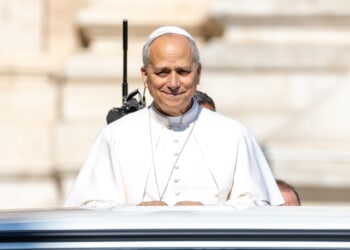Earlier this summer, New York Gov. Kathy Hochul announced the state’s plans to construct a new nuclear power plant, reversing the result of a decades-long campaign against atomic energy in the state.
Now, the project is facing regulatory challenges and political pushback by other New York Democrats, including by a group that campaigned alongside progressive favorite Zohran Mamdani last year. Hochul herself already declared war on fossil fuels since the beginning of her term, trapping her energy policies between a rock and a hard place as it became clear that progress on renewables is simply too slow to meet the state’s energy needs alone.
If she and other moderate Democrats want to save the state energy grid, it will mean allying with nuclear and natural gas – and snubbing the state’s far-left progressives.
New York State has long managed to squander its opportunities for energy abundance. Under Andrew Cuomo, the state caved to progressive environmental activists who pushed the closing of the Indian Point nuclear plant, claiming that earthquakes or tsunamis in New York’s Hudson Valley could cause a catastrophic accident like the one at Japan’s Fukushima Daiichi Nuclear Power Plant that killed one person. Activists at the time also raised concerns about fish safety, incorrectly claiming that the plant was using “…the Hudson River as a dumping ground for radioactive waste.” Cuomo applauded the plant’s closing as a win for New York City, saying, “I have personally been trying to close it down for 15 years.” (RELATED: CRAIG RUCKER: Preserving America’s Freedom Means Producing More Energy)
Rather than being a win for the environment, the closing of Indian Point led to more fossil fuel usage, not less. In the first full month after the plant’s closing, New York’s carbon emissions increased 35%, while natural gas generation spiked from 35% to 39%, dashing the hopes of those who dreamed that nuclear energy would simply be replaced by renewables.
This increased reliance on natural gas, however, was at odds with New York leadership’s insistence on emission-free energy sources, leaving the state in a bind. Cuomo continued his climate crusade, advancing the Climate Leadership and Community Protection Act (CLCPA), which calls for New York to run on 70% zero-emission energy by 2030 and 100% zero-emission energy by 2040. His successor, Kathy Hochul, then touted high hopes of achieving this with a combination of ambitious spending on renewables projects and a cap-and-invest scheme to penalize emissions, but later punted on the latter plan after it became clear that the plan would inevitably just raise energy prices for New Yorkers.
Now, Hochul says she’s “slowing things down” after realizing that it won’t be possible to meet the goals set by the CLCPA, finally changing the state’s tune and admitting that renewables alone would not be sufficient. “We’re going to have to do more than just rely upon wind and solar and thermal,” adding that she wants to return to the energy source the state had previously turned its back on at Indian Point: “I want to lean into nuclear power.”
This pragmatism, however, has gone predictably unappreciated by New York progressives, who see nuclear power as a threat to a renewables-only approach to zero-emission energy. New York City mayoral candidate Zohran Mamdani and groups of “ecosocialists” are now insisting that “utilities suck,” and accuse Hochul of “giving up on climate goals” instead of using the state’s Green New Deal legislation to take control and socialize power.
These groups are renewables-only as a route to zero-emission energy, decrying nuclear power’s “legacy of negative impacts on Indigenous communities, women, and children,” calling existing nuclear technology “aging” and claiming that new technology is “untested” and costly, advocating instead for the buildout of public solar and wind. Progress on renewables remains slow, however, with solar and wind combined accounting for under 5% of New York’s energy.
With growing energy concerns around AI and data centers, Hochul warns that the state “will see rolling blackouts” if it fails to radically increase its energy supply for the coming decade.
New York State’s lofty goals for its energy grid have only gotten the state as far as passing policy, but reality is finally settling in for Democrats now that the electric bill is due. Hochul must learn what her predecessors did not: allowing progressives to set the terms of New York’s energy policy is a recipe for overpromising and overpaying. The fate of New York State’s energy grid depends on it.
Alina Voss is a fellow with ConservAmerica.
The views and opinions expressed in this commentary are those of the author and do not reflect the official position of the Daily Caller News Foundation.
All content created by the Daily Caller News Foundation, an independent and nonpartisan newswire service, is available without charge to any legitimate news publisher that can provide a large audience. All republished articles must include our logo, our reporter’s byline and their DCNF affiliation. For any questions about our guidelines or partnering with us, please contact licensing@dailycallernewsfoundation.org.





![Gavin Newsom Threatens to 'Punch These Sons of B*thces in the Mouth' [WATCH]](https://www.right2024.com/wp-content/uploads/2025/08/Gavin-Newsom-Threatens-to-Punch-These-Sons-of-Bthces-in-350x250.jpg)
![ICE Arrests Illegal Alien Influencer During Her Livestream in Los Angeles: ‘You Bet We Did’ [WATCH]](https://www.right2024.com/wp-content/uploads/2025/08/ICE-Arrests-Illegal-Alien-Influencer-During-Her-Livestream-in-Los-350x250.jpg)







